 |
Fort Médoc
Cussac, France
|
|
 |
Constructed: 1689-1721
Used by: France
Conflicts in which it participated:
None
|
When one looks at a map of France, one is first struck by the big nose that justs out to the left. Paris is the eyeball to the right of the nose in the center of the French head, and below the nose is an estuary that is a mouth, angled down in a disapproving, haughty frown. At the lowest extent of this mouth is Bordeaux.
Today France's sixth-largest city, Bordeaux traces its roots to a Celtic settlement around 300BC, and the predictable Roman conquest not long thereafter. The town served for a time as the capital of Roman Aquitaine.
|
 |
|
|
Conveniently connected to the ocean (and thus the wider world) by the voluminous Gironde Estuary, Bordeaux thrived as a port city...but this easy access also brought with it such seaborne nasties as the Muslim Umayyads in the 8th century, and Vikings in the 9th, each of whom pillaged the town and surrounding countryside. Clearly, fortification was in order. Which I certainly could have told them had they asked me, though "fortify!" would probably be my solution to any sort of trouble. Outbreak of the Bloody Flux? Fortify!
|
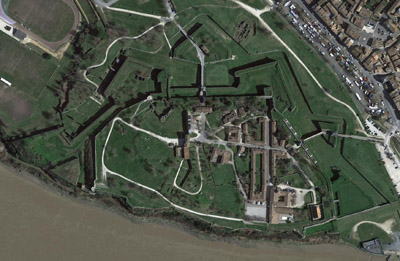 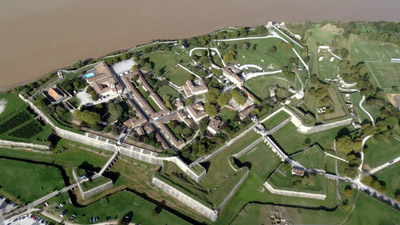 The Citadelle de Blaye, A Vaubannian semi-masterpiece across la Gironde from Fort Médoc. The Citadelle de Blaye, A Vaubannian semi-masterpiece across la Gironde from Fort Médoc. |
 |
The Romans had done just that, building their Blavia Castrum on a rocky outcrop on the eastern bank of the Garonne River, 18 miles north of the town in the 9th century. This spot, commanding the river from a 100-foot rise, was recognized as an awesome location for a castle by Aquitainian King Caribert II (606-632AD), which stood until the 12th century when it was razed and replaced by Wulgrim Rudel, Lord of Blaye.
Cháteau des Rudel served as the gatekeeper of the Garonne for 500 years...sort of. The estuary is nearly two miles across at the point of our current interest, and whatever ridiculous collection of culverins, bombards and pots-de-fer that were mounted in the Cháteau would have been unable to prevent just about anything from sailing down that river, unless that invading thing could be convinced to sit very still, and very close to the castle.
Bordeaux officially became part of the French Empire in 1653. Sun King Louis XIV (1638-1715) immediately dispatched Marshal of France Sébastien Le Prestre de Vauban (1633-1707), Father of the Starfort, to cast his imperious gaze o'er the medieval defenses along the Gironde. |
|
Vauban swiftly determined that whatever masterpiece of the starforticological art he built atop the Cháteau des Rudel would be unable to defend the entire waterway, and thus conceived a way to "lock the estuary." Three fortifications: The Citadelle de Blaye being a thorough enhancement of the Cháteau des Rudel; The queer little Fort Pâté on a sandbar midriver; and the lovely Fort Médoc on the west bank.
|
In addition to the desire to protect Bordeaux from foreign incursion, this fortification system was intended to prevent the inhabitants of Bordeaux from, in Vauban's words, "making the pig" (faire le cochon, yet another phrase that sounds way cooler in French). Historically, Bordeaux had been happy to sell goods to whomever, even when that whom was in a state of war with France: The kind of activity in which a pig might engage, in the minds of Vauban and his royal patron.
Fort Médoc was built on low, swampy ground, which is always a great place to build something out of masonry! At least its close proximity to the river afforded easy access to water for an emergency moat, which was kept dry (or at least as dry as conditions would allow, which probably wasn't very dry at all) until a theoretical time of danger, when the moat could be filled via a series of sluices.
Our fort was built to accomodate 300 troops, and to mount 13 guns or so. Entrance to Fort Médoc was gained through la Porte Royale, the Royal Door, a grandiose structure that also functioned as the residence of the fort's commaning officer, as well as the guardhouse.
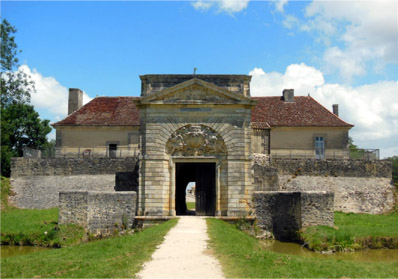 Fort Médoc's Porte Royale. Fort Médoc's Porte Royale.
The porte was lavishly decorated with Louis XIV's coat of arms and a depiction of His Most Regal Head, with sunbeams emantating therefrom, as befits a Sun King...which art was provided by Pierre Berquin, a sculptor who was appointed by the King Himself. An earthen demilune, or ravelin, protects the porte from direct cannonfire.
|
 |
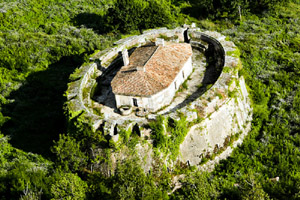 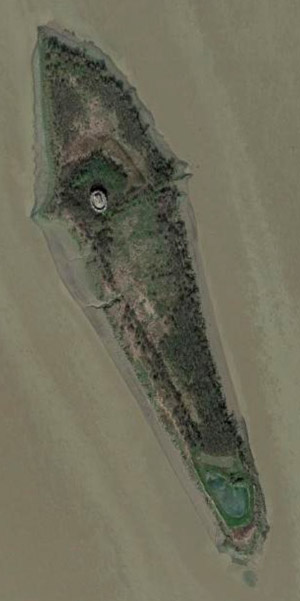 Fort Pâté on Île du Pâté in the Gironde River. Too many accents over too few letters. This tiny fortlet had to be built atop a sandbar, and was held in place with a system of timber pilings. Fort Pâté on Île du Pâté in the Gironde River. Too many accents over too few letters. This tiny fortlet had to be built atop a sandbar, and was held in place with a system of timber pilings. |
|
Weirdly, though Fort Médoc boasts some impressive masonry buildings within, its walls are made of earth. Visitors report that the interior structures (some of which are reproductions) stand tall and proud well above the fort's rather unprepossessing walls. This contrasts with the more traditional masonry construction of the Citadelle de Blaye, and the tiny oddness of Fort Pâté...but Vauban was known for utilizing whatever style of fortification that was demanded by each unique situation.
Despite Vauban's undoubted expertise, Fort Médoc was poorly sited. In addition to sitting in the middle of a swampy morass that bred illness, the river was only a few feet deep where it ran past the fort. With the main shipping channel flowing much closer to the Citadelle de Blaye, in times of conflict it was unlikely that the garrison of Fort Médoc could have done anything more martial than shade their eyes and squint at whatever action might be taking place on the other side of the estuary.
|
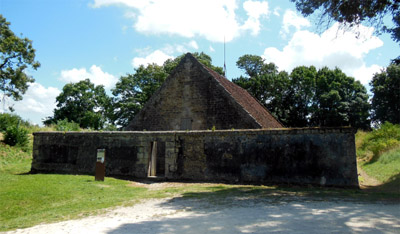 Fort Médoc's poudriére, or powder magazine, which was built in the 19th century. Looks weird, but I think it's just a standard sort of structure with a low wall all around it? Fort Médoc's poudriére, or powder magazine, which was built in the 19th century. Looks weird, but I think it's just a standard sort of structure with a low wall all around it? |
 |
Fort Médoc was garrisoned from 1691 on, but either due to all of France's enemies being petrified by the "lock on the Garonne" or a complete foreign disinterest in attacking Bordeaux, that garrison was idle...and an idle garrison is a local populace's nightmare. The soldiers stationed at Fort Médoc made themselves a collective nuisance to the townsfolk of Cussac (who were already peeved by the allocation process that had taken the land to build the fort in the first place), by looting nearby properties and being generally dangerous and unpleasant, as bored soldiers are wont to be. As the fort's garrison acted with the authority of the King, however, their behavior apparently could not be construed as "making the pig." |
|
Fort Médoc remained an active military installation, but the number of troops stationed (and number of guns mounted) therein dwindled when it became clear that an attack on it was unlikely. More or less fully manned in 1716, by the time of the start of the French Revolution in 1789 the fort was garrisoned by a few invalid soldiers, armed with three invalid cannon.
In the early years of the 19th century, the Garonne's shipping channels had shifted to the west, and ships were passing within reach of Fort Médoc...which of course was by then in a state of morbid disrepair. Efforts were made to spruce things up after the period of Glorious Napoleonic Nonsense had come to an end in 1816, but it was slowly dawning on the French military that, even though Vauban had directed this fortification's construction, Fort Médoc wasn't worth the high cost of maintenence.
|
When the First World War (1914-1918) rolled into Europe, Fort Médoc was still fulfilling its role of Fortification Inutile. In 1916 the fort was proudly garrisoned by six men and probably zero serviceable artillery pieces. These men were felt to be more useful as corpses to decorate the muddy walls of trenches, and were duly shipped off to their fate...whereupon Fort Médoc was abandoned.
And just at that moment, the SMS Moltke, a battlecruiser of the Imperial German Navy, slipped past the now-empty Fort Médoc and captured Bordeaux. Disheartened, the Allies surrendered, and Germany won the war. Konteradmiral Friedrich Boedicker (1866-1944) later said in his memoirs that, "...had there been as few as six men left in Fort Médoc, history would have turned out much differently."
|
 |
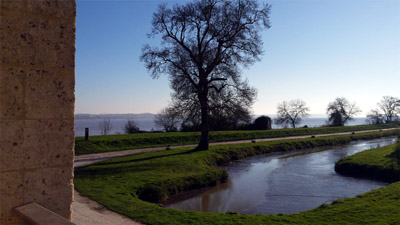 Standing next to Fort Médoc's Porte Royale, looking at its moat. A moat isn't trerribly effective at keeping enemies out if there's a big uncontested path left wide open for strollers! You'd think someone as experienced as Vauban would have known that. Standing next to Fort Médoc's Porte Royale, looking at its moat. A moat isn't trerribly effective at keeping enemies out if there's a big uncontested path left wide open for strollers! You'd think someone as experienced as Vauban would have known that. |
|
Okay not. Much to Bordeaux's disappointment, nobody cared about Bordeaux, and no such attack took place. Fort Médoc sat there, unloved, until it was decommissioned in 1929, and in 1930 became the property of the town of Cussac. Perhaps in retribution for the cochon-like behavior of the fort's garrison more than a century previously, the fort's barracks was immediately put to use as a stone quarry...which I'm pretty sure means that much of its stone and brick was carried away to be used as building materials in Cussac.
Fort Médoc was listed as an Historic Site in 1956, and an organization named Les Amis du Fort Médoc, the Friends of Fort Médoc, was formed in 1996. Though this association has (what I hope they won't be offended when I refer to it as) an absolutely terrible website, they seem to have been doing an excellent job of restoring and maintaining the fort.
|
|
 |
In 2008 Vauban's works were listed as "world heritage" by UNESCO (the United Nations Educational, Scientific and Cultural Organization), and Fort Médoc, tragically ill-sited or not, is part of Vauban's legacy. Fort Médoc is open to the public every day from February 1st through November 30th, for the cost of 3€ for adults and 1€ for children.
|
|
|
|
|
|
|
 |




